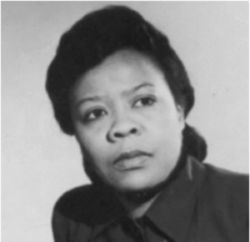Since 1976 February has been recognized as Black History Month in the United States, a time dedicated to honoring the accomplishments and contributions of individuals within the African diaspora. Black history and disabled history are intertwined as Black disabled individuals, and Black supporters without disabilities have played an integral role in amplifying disability rights and inclusion. In both past and present times, Black people have committed their life’s work to demonstrating their support to disability rights in various capacities as frontline activists, inventors, and influencing disability policy within the United States government.
Throughout the month of February, the Center for Learner Equity will honor Black History Month by highlighting the contributions of Black people in disability rights and inclusion. We’ll kick-off the month by honoring nurse and inventor, Bessie Blount.
Bessie Virginia Blount was born in 1914 in rural Virginia. At the age of seven, she moved to Newark, New Jersey where she would go on to study physical therapy at Union Junior College (now Union County College). Blount would continue her studies at Panzer College of Physical Education and Hygiene, now part of Montclair State University. Upon completing her education, Blount would become a licensed physiotherapist at the Bronx Hospital in New York City.
While working at the hospital, many of Blount’s patients were World War II veterans that had their arms amputated after sustaining injury in the war. During her time with the patients, Blount taught them how to write with their teeth and feet. After taking notice of Blount’s work, a doctor suggested that she create a device that could help the patients feed themselves.
Throughout the course of 10 months, Blount designed her first prototype of what she called an “invalid feeder” utilizing a file, plastic, hammer, ice pick, dishes and boiling water to melt the plastic into a mold. To operate the device, a patient would bite down on a tube activating a motor to dispense a small amount of food through a spoon-shaped mouthpiece. Between each delivery of food, the device would automatically shut off to allow the patient time to chew.
Blount’s innovation was hailed as “a most ingenious apparatus” by Dr. Malcolm MacEachern, the director emeritus of the American College of Surgeons.
To learn more about Bessie Blount’s life, contributions to healthcare and individuals with disabilities, click here.

Comments are closed.